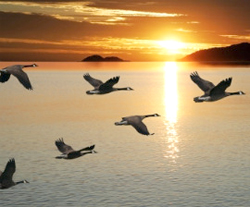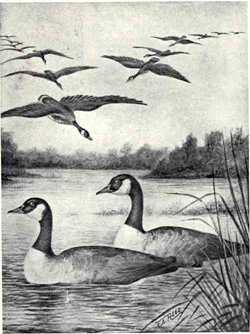Some Geese Stay Put All Year
The Canada goose is a wild goose with a black head and neck, white patches on the face, and a brownish-gray body native to arctic and temperate regions of North America and can be found all over North America at various times of the year.
The Canada goose is naturally migratory with the wintering range being most of the United States. Some of the population has become non-migratory due to adequate winter food supply and a lack of predators.
The annual migrations these birds make between their breeding and wintering grounds is one of the wonders of the world. They follow broad but well defined migration routes called flyways or migration corridors. Canada geese leave the winter grounds more quickly than the summer grounds. Geese breed in the north and begin their journey south following coastlines, rivers and mountain ranges.
Most Canada geese have staging or resting areas where they join up with others.
Their autumn migration can be seen from September to the beginning of November. These geese are renowned for their V-shaped flight formation. The front position is rotated since flying in front consumes the most energy. By taking advantage of the wing tip vortex of the bird in front, each bird can save energy by reducing drag. The energy savings in flight can be as much as 50 percent.
Each grand flying V, as it passes over the lake, breaks formation, then drops to the water's surface with a controlled grace that belies a bird weighing up to 15 pounds.
They can fly over 55 miles per hour and travel more than 600 miles in a day.
The life span range up to 24 years or longer.
In the spring, they head back north to Canada, Alaska and the northern U.S. where they congregate in large numbers to start new families, build their nests and seek out mates on local marshes, streams, lakes and ponds.
The species ranges from 30" to 43" in length and has a 50" -73" wingspan. The male weighs 7-15 lb, and can be aggressive in defending territory. The female looks identical but is smaller than the male and has a different honk.
Spending up to 12 hours a day eating, the birds require a great deal of nutrition - especially females during the spring mating season. Canada geese eat green vegetation and grains, and sometimes small insects and fish. It feeds by grasping a blade of grass with the bill, then tearing it with a jerk of the head. The Canada goose will eat farm crops when available. In the water, it feeds from silt and on aquatic plants. In urban areas, they pick food out of garbage bins.
Spring mating and the nesting season are characteristically active with wing-bashing, chasing and aggressive honking, noise and splashing.
Gregarious and talkative, the Canada goose has many distinct calls and is considered almost as "chatty" as humans. Goslings begin vocalizing while still in the egg.
During the second year of their lives, Canada geese find a mate. The geese are monogamous; most couples stay together for life. If one dies, the other may find a new mate.
Eggs are laid in a shallow depression lined with plant material and down.
Often nesting on islands in small ponds, rivers or marshes, a female will lay between five to seven eggs over several days in a clutch. After about 25-30 days during which the female incubates while the male remains nearby protecting the nest from predators, the goslings will peck their way out, emerging as bright yellow, fluffy chicks.
They take to the water and begin eating immediately to gain the strength they will need to migrate. Males and females co-parent, and it's not unusual to see the family in formation with the parents at each end.
Egg and gosling predators include coyotes, foxes, raccoons, large gulls, raven, crows and bears.
As the annual summer molt takes place during the breeding season, the adults lose their flight feathers for 20-40 days, regaining flight at about the same time their goslings start to fly.
Parents often violently chase and attack predators with bites and slaps of the wings, after warning them with a hissing sound.
Geese will attack humans when threatened. First the geese will stand erect, spread their wings and produce a hissing sound. Next, the geese will charge. They may bite or attack with their wings.
Although parents are hostile to unfamiliar geese, they may form groups of a number of goslings and a few adults, called creches.
The offspring do not leave their parents until after the spring migration, when they return to their birthplace. Once they reach adulthood, Canada geese are rarely preyed on, but are taken by coyotes, gray wolves, snowy owls, golden eagles and bald eagles.
In North America, non-migratory Canada goose populations have been on the rise. The reason is two-fold: Their natural predators (coyotes, fox, wolves, owls, and eagles) diminished in many regions; and man-made bodies of water on golf courses, in parks and in planned communities abound, so food is available year-round, including human food.
Since 1999, The United States Department of Agriculture Wildlife Services agency has been engaged in lethal culls of Canada geese for municipalities or private land owners, such as golf courses, who find the geese obtrusive or object to their waste.

